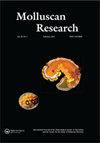使用高通量短读数据集生成西南太平洋濒危扁螺的大线粒体和核苷酸序列以及系统发育分析
IF 0.6
4区 生物学
Q3 ZOOLOGY
引用次数: 2
摘要
平原蜗牛科是西南太平洋特有的陆生蜗牛亚科。一些物种被收割作为食物,而另一些则处于极度濒危状态。在这里,我们收集并表征了来自三个地理区域(新西兰、新喀里多尼亚和所罗门群岛)的五种蜗牛的完整线粒体基因组,以及三个核标记(部分45S核糖体盒和组蛋白基因H3和H4)。蜗牛的线粒体基因组分布在14544个之间 bp和14711 在tRNA酪氨酸(Y)和tRNA色氨酸(W)的位置上有微小变化。45S核糖体盒包含ITS2的基因组内核苷酸变异。为三个物种组装了含有组蛋白基因H3和H4及其非转录间隔区的盒,这两个基因的编码方向相同。这个大型数据集的系统发育分析(线粒体基因组 + 核标记)支持物种的地理聚类,但不能可靠地推断出四个Placostylus物种相对于Eumecostyluscleryi的单系性。基于较短的细胞色素c氧化酶序列和较宽的分类单元采样进行的分析发现,代表Eumecostylus属和Placocharis属的物种嵌套在Placostyrus的系统发育多样性中。包含线粒体和核序列的多基因座系统发育分析不支持单系性。本文章由计算机程序翻译,如有差异,请以英文原文为准。
Generation of large mitochondrial and nuclear nucleotide sequences and phylogenetic analyses using high-throughput short-read datasets for endangered Placostylinae snails of the southwest Pacific
ABSTRACT Placostylinae are a sub-family of terrestrial land snails endemic to the southwest Pacific. Some species are harvested for food, and others are critically endangered. Here we assemble and characterise complete mitochondrial genomes, as well as three nuclear markers (partial 45S ribosomal cassettes and the histone genes H3 and H4) of five snail species from three geographical regions (New Zealand, New Caledonia and the Solomon Islands). Mitogenomes of Placostylinae snails ranged between 14,544 bp and 14,711 bp, with minor variation in the position of tRNA tyrosine (Y) and tRNA tryptophane (W). The 45S ribosomal cassette contained intra-genomic nucleotide variation in ITS2. Cassettes containing histone genes H3 and H4 and their non-transcribed spacer region were assembled for three species, with the two genes coded in the same direction. Phylogenetic analysis on this large dataset (mitochondrial genome + nuclear markers) supported geographical clustering of species but could not confidently infer monophyly of the four Placostylus species with respect to Eumecostylus cleryi. Analysis based on shorter cytochrome c oxidase sequences with a wider taxon sampling found species representing the genera Eumecostylus and Placocharis were nested within the phylogenetic diversity of Placostylus. Multi-locus phylogenetic analysis containing mitochondrial and nuclear sequences did not support monophyly of Placostylinae.
求助全文
通过发布文献求助,成功后即可免费获取论文全文。
去求助
来源期刊

Molluscan Research
生物-动物学
CiteScore
1.80
自引率
10.00%
发文量
27
审稿时长
>12 weeks
期刊介绍:
Molluscan Research is an international journal for the publication of authoritative papers and review articles on all aspects of molluscan research, including biology, systematics, morphology, physiology, ecology, conservation, biogeography, genetics, molecular biology and palaeontology.
While the scope of the journal is worldwide, there is emphasis on studies relating to Australasia and the Indo-west Pacific, including East and South East Asia. The journal’s scope includes revisionary papers, monographs, reviews, theoretical papers and briefer communications. Monographic studies of up to 73 printed pages may also be considered.
The journal has been published since 1957 (as the Journal of the Malacological Society of Australia until 1993). It is free to members of the Malacological Society of Australasia and the Society for the Study of Molluscan Diversity.
 求助内容:
求助内容: 应助结果提醒方式:
应助结果提醒方式:


